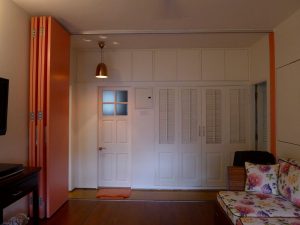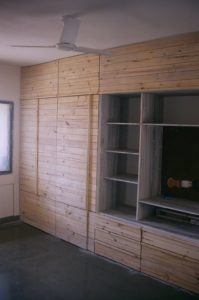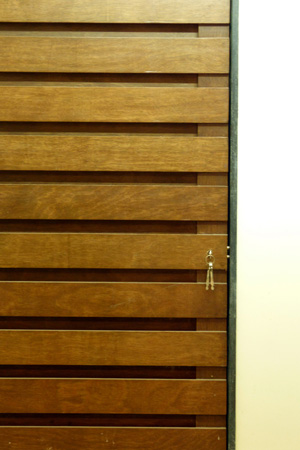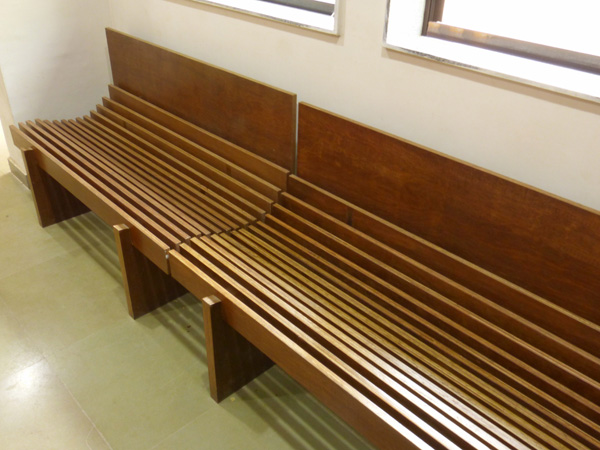Standardisation is a virtue of large scale manufacturing. Advances in technology and changes in Government policy catalyses invention and delivery of new materials and products. Entrepreneurs who run these businesses invest hugely and heavily advertise their products in the media and other means. Their competitors quickly follow and the market is flooded with similar goods. The users have no other option but to consider these for their projects. This in brief is one simple way how the market works.
In India, the penetration of cheaper standard products has still not affected the building ecosystem due to abundance of labour. It has withstood the advent of businesses like Pepperfry, Urban ladder, FabIndia, Godrej Interio etc. Global giant IKEA has just entered the country, let us wait and watch if they are in a position to disrupt the present paradigm.
These ideas & products become a trend purely because of its availability and newness. Using any other material then becomes an exercise in sourcing it and finding skilled workers to craft it and researching on techniques of using them. Supplementary works in form of treatments and finishes too become an added project in itself. A simple task of installing Stone tiles for flooring has become an expensive adventure. Finding good quality, less variations, pre-cut stone and further finding masons to shape it in with crisp edges and right-angled corners, install it in plumb & level, Polish it to mirror perfection… seems like a lost art. Not that it can’t be done right, but it comes at a cost where a it is beyond the affordability of the general public. The new age floors like Synthetic marbles, Vitrified tiles, Resins, Vinyls, faux Wood, have their virtues, but are not necessarily the only desired options.
Natural materials are the best when it comes to sensory experiences. Wood, Stone, Earth, Fabrics, etc. transmit a certain quality of energy that soothes our soul. Majority of the new material and products are designed to look like the natural materials, because the market still perceives it to be the ideal feel & finish and the preferred material of choice of the people. They only mimic the graphical character but do not possess any positive property or value of the original – natural counterpart. The advantage that the new material possess is that they are pre-finished, cheap and easy to install, WYSIWYG – What you see is what you get! No wonder people fall for cheap products.
There are alternatives though. One needs a sense of adventure to accept a unconventional material at first, but I assure you that one will be a different person once you use them. Alternative materials are comparatively cheaper only due to its uniqueness, but their value is much greater. It is difficult to find them or even identify them, but a little research will surely lead one to the experts.
Salvaged (Old) Wood
 Wooden Door and Windows salvaged from old buildings, Wooden beams & columns, staircase treads, Grills, Railings are beautiful elements and materials. The old wood is a well seasoned material, free of any moisture hence it does not warp. The fact that it is still robust is a sign of its quality. Wood as a material has an eternal life. Its structure is its beauty, one doesn’t have to apply any other material to enhance it.
Wooden Door and Windows salvaged from old buildings, Wooden beams & columns, staircase treads, Grills, Railings are beautiful elements and materials. The old wood is a well seasoned material, free of any moisture hence it does not warp. The fact that it is still robust is a sign of its quality. Wood as a material has an eternal life. Its structure is its beauty, one doesn’t have to apply any other material to enhance it.
Check out: http://www.aaweb.in/projects/interiors/sustainable-house-in-thane/
Pine wood Packaging
 Pine wood used in packaging is also cheaply available. These are generally part of the packaging that comes with heavy products imported from abroad. The figures in pine wood are very crisp and articulate. Pine wood is very light in weight and soft compared to standard wood used for furniture. The use of pine is principally for its beauty. Products purely made of pinewood are massive yet light to the eye due to its colour. One can used coloured pigments in polish to stain pine wood and obtain an amazing combination of colour and figures.
Pine wood used in packaging is also cheaply available. These are generally part of the packaging that comes with heavy products imported from abroad. The figures in pine wood are very crisp and articulate. Pine wood is very light in weight and soft compared to standard wood used for furniture. The use of pine is principally for its beauty. Products purely made of pinewood are massive yet light to the eye due to its colour. One can used coloured pigments in polish to stain pine wood and obtain an amazing combination of colour and figures.
Check out: http://www.aaweb.in/projects/interiors/pine-wood-house/
Unfinished Plywood
 Plywood is a standard building material. It has a better environmental value that new wood as it is engineered keeping in mind that there should be minimum wastage while it is derived from lumber. Ply is primarily used as a ‘structure’ for all furniture today. It is clad with laminates and veneers to create a layer of aesthetics for the furniture. To reduce the cost of labour and extra materials in a typical ply construction, we considered using ply in its raw state. We are able to get economy by doing so. The advantage is that the we can use the highest grade of ply, which is prohibitively expensive and achieve a better life for the furniture. In doing so, we still can make it cheaper than the conventional way of clad-ply furniture. The higher grades of ply have a better looking veneer which looks good when polished. We have to take extra care while constructing it though, such that while cutting the veneer it should not chip and flare at the edges and the figures of adjacent surfaces of the furniture should be seamless in colour and figure. The edges (dhar) of the ply is also kept open unlike the normal practice of applying ‘moulding’ strips. This has to be done if cheaper variety of ply is used, as it tends to split due to lower quality of adhesives used for making ply. The real edges of ply has its own aesthetics. The layers of ply as seen on the edge are uniform lines of dark and light ply. A play of ply ‘surface and edges’ in the furniture can help create a unique visual composition.
Plywood is a standard building material. It has a better environmental value that new wood as it is engineered keeping in mind that there should be minimum wastage while it is derived from lumber. Ply is primarily used as a ‘structure’ for all furniture today. It is clad with laminates and veneers to create a layer of aesthetics for the furniture. To reduce the cost of labour and extra materials in a typical ply construction, we considered using ply in its raw state. We are able to get economy by doing so. The advantage is that the we can use the highest grade of ply, which is prohibitively expensive and achieve a better life for the furniture. In doing so, we still can make it cheaper than the conventional way of clad-ply furniture. The higher grades of ply have a better looking veneer which looks good when polished. We have to take extra care while constructing it though, such that while cutting the veneer it should not chip and flare at the edges and the figures of adjacent surfaces of the furniture should be seamless in colour and figure. The edges (dhar) of the ply is also kept open unlike the normal practice of applying ‘moulding’ strips. This has to be done if cheaper variety of ply is used, as it tends to split due to lower quality of adhesives used for making ply. The real edges of ply has its own aesthetics. The layers of ply as seen on the edge are uniform lines of dark and light ply. A play of ply ‘surface and edges’ in the furniture can help create a unique visual composition.
Check out: http://www.aaweb.in/projects/interiors/plywood-house-in-kharghar-navi-mumbai/
In our persistent practice of providing our clients with the best at reasonable costs we have identified and tested various materials & products which provide a welcome relief from trendy building materials. Most of these are derived from used items and creative use of abundant material perceived as ‘waste’ or by smart re-use of material & products on site. Using alternative materials creates a deep sense of achievement amongst people. The sense of doing a bit towards the environment also brings pride and the value of the product is elevated considerably in the minds of the users.
